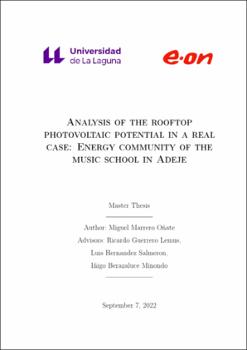Analysis of the rooftop photovoltaic potential in a real case: Energy community of the music school in Adeje
Author
Marrero Oñate, MiguelDate
2022Abstract
Rooftop photovoltaic emerges as an essential resource to promote the energy transition. It opens up the possibility to create energy communities and
share the generated electricity within a neighbourhood, aiding to confront the
energy crisis. However, low voltage distribution grids where originally designed radially, with a mainly one-directional power flow in mind. As such,
a high penetration of distributed generation such as rooftop photovoltaic will
negatively impact the grid, increasing the voltage profile and causing reverse
power-flows. Thus, it is key to determine the limits set by the applicable regulation and analyze the effects of rooftop photovoltaic on the grid performance.
This work aims to determine the impact on the distribution grid of an
intense deployment of rooftop photovoltaic in a real case scenario, the surroundings of the music school in Adeje, Tenerife (Spain). For this purpose,
the current statutory limits, as well as the network topology, the rooftop area
and real consumption data of the vicinity are taken into account. A simulation is performed using the software OpenDSS, and the influence on the grid
is estimated for different penetration scenarios. The results show that the
transformer capacity limitation allows the integration of 420kWp. Setting this
limitation aside, this value could be increased up to 579kWp without surpassing voltage limits, while the maximum photovoltaic potential in the vicinity
according to available rooftop area is estimated at 1859,21kWp, but it would
breach the current grid codes. To allow higher penetration limits, solutions
such as the Volt-Var and Volt-Watt techniques as well as distribution static
synchronous compensators are required.





